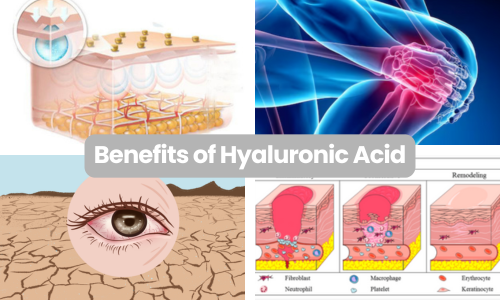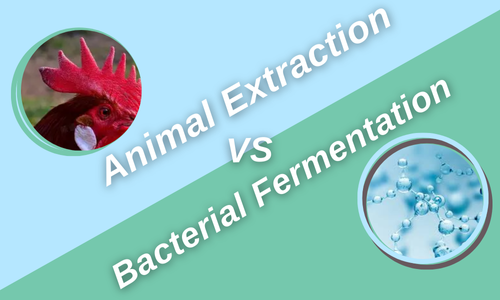Comprehensive Guide to Hyaluronic Acid: Sources, Benefits, and Types
Hyaluronic acid (HA) is a substance with applications ranging from skincare and beauty to medical and injection uses. Sodium hyaluronate is its sodium salt form, which is more stable and serves as the primary form in practical applications.
HA exists in various forms, including powder, liquid, and gel. Among, powder being the most stable and commonly used. If you’re considering to buy hyaluronic acid, you should understand its benefits, categories, and sources.
What Is Hyaluronic Acid?
This glycosaminoglycan acts as nature’s moisturizer. It is capable of holding up to 1,000 times its weight in water. Found abundantly in skin, joints, and eyes, it provides lubrication, hydration, and structural support. The natural hyaluronic acid in our bodies diminishes with age. It is why supplementation through skincare or oral products has become increasingly popular.
What Does Hyaluronic Acid Do?
- Skin Hydration and Anti-Aging
Why is hyaluronic acid considered good for the skin? Because it enables hydration, holding 1000x its weight in water to plump fine lines and boost elasticity. It strengthens the skin barrier, soothes irritation, and works for all skin types without clogging pores. It’s the ability to retain moisture and support collagen.
- Joint Lubrication
HA injections and oral supplements help lubricate joints, reducing pain and stiffness in osteoarthritis patients.
- Wound Healing and Tissue Repair
Medical-grade HA accelerates tissue regeneration, making it useful in post-surgical recovery and chronic wound care.
- Eye Health
Hyaluronic acid is a key ingredient in eye drops for dry eye syndrome, providing long-lasting lubrication.
Reading more: What is Sodium hyaluronate Powder? Benefits and Usage
Categories of Hyaluronic Acid by Application
Hyaluronic acid is segregated into different grades based on molecular weight and purity, each with a specific use.
- Cosmetic-Grade Sodium hyaluronate
Used in skincare products like serums, creams, and masks, cosmetic-grade HA comes in various molecular weights:
- High Molecular Weight (HMW) HA: Forms a hydrating film on the skin’s surface, reducing trans-epidermal water loss.
- Low Molecular Weight (LMW) HA: Penetrates deeper into the skin for long-lasting hydration and collagen stimulation.
- Medical-Grade Sodium hyaluronate
This grade is used in wound healing, eye drops (for dry eye treatment), and post-surgical recovery products. It has higher purity standards than cosmetic-grade HA.
Reference: Medical-Grade vs. Injectable-Grade Sodium Hyaluronate: Which Has Stricter Requirements
- Injection-Grade Sodium hyaluronate
Injectable HA is highly purified and sterilized for use in:
- Dermal Fillers: To reduce wrinkles and add volume.
- Joint Injections: For osteoarthritis treatment (e.g., viscosupplementation).
This form requires stringent regulatory approval (e.g., FDA, CE) to ensure safety.
- Food-Grade Sodium hyaluronate
In powder or capsule form, food-grade HA is applied to enhance joint well-being, skin moisturizing, and digestive health.
How is Hyaluronic Acid Produced?
Hyaluronic acid is naturally present in the human body, especially in the skin, joints and eyes, to lubricate and moisturize. Still, for commercial and industrial applications, have two main ways produced.
- Animal Extraction
Previously, HA powder was obtained from animal tissue such as rooster combs and bovine vitreous humor. While it is functional, the method included a certain risk of allergic reaction and potential pollution. Furthermore, animal-derived HA is not vegan-compatible, leading to a shift towards microbial fermentation.
- Bacterial Fermentation (Vegan Hyaluronic Acid)
Today, most commercial hyaluronic acid is produced by the streptococci or bacterial fermentation with other non-rational bacteria. This process causes high purity, reduces the incidence of animal-borne impurities, and is compliant with vegetarian and cruelty. Biofermented HA is now the product of choice for cosmetic, medical, and food-grade applications. Most good-quality HA sold today, including Stanford Chemicals Company, is produced by microbial fermentation.
Read more: How is Hyaluronic Acid Powder Made
Conclusion
Hyaluronic acid is a versatile compound ranging from skin care to medical treatment. Thanks to the progress of biofination, high-quality, vegetarian hyaluronic acid is now widely available. Whether you need sodium hyaluronate powder for supplements, injected for joint therapy, or cosmetic serum for glowing skin, understanding the different forms ensures the best option for your needs.
For premium-quality sodium hyaluronate powder tailored to various industries, please get in touch with Stanford Chemicals Company (SCC).


